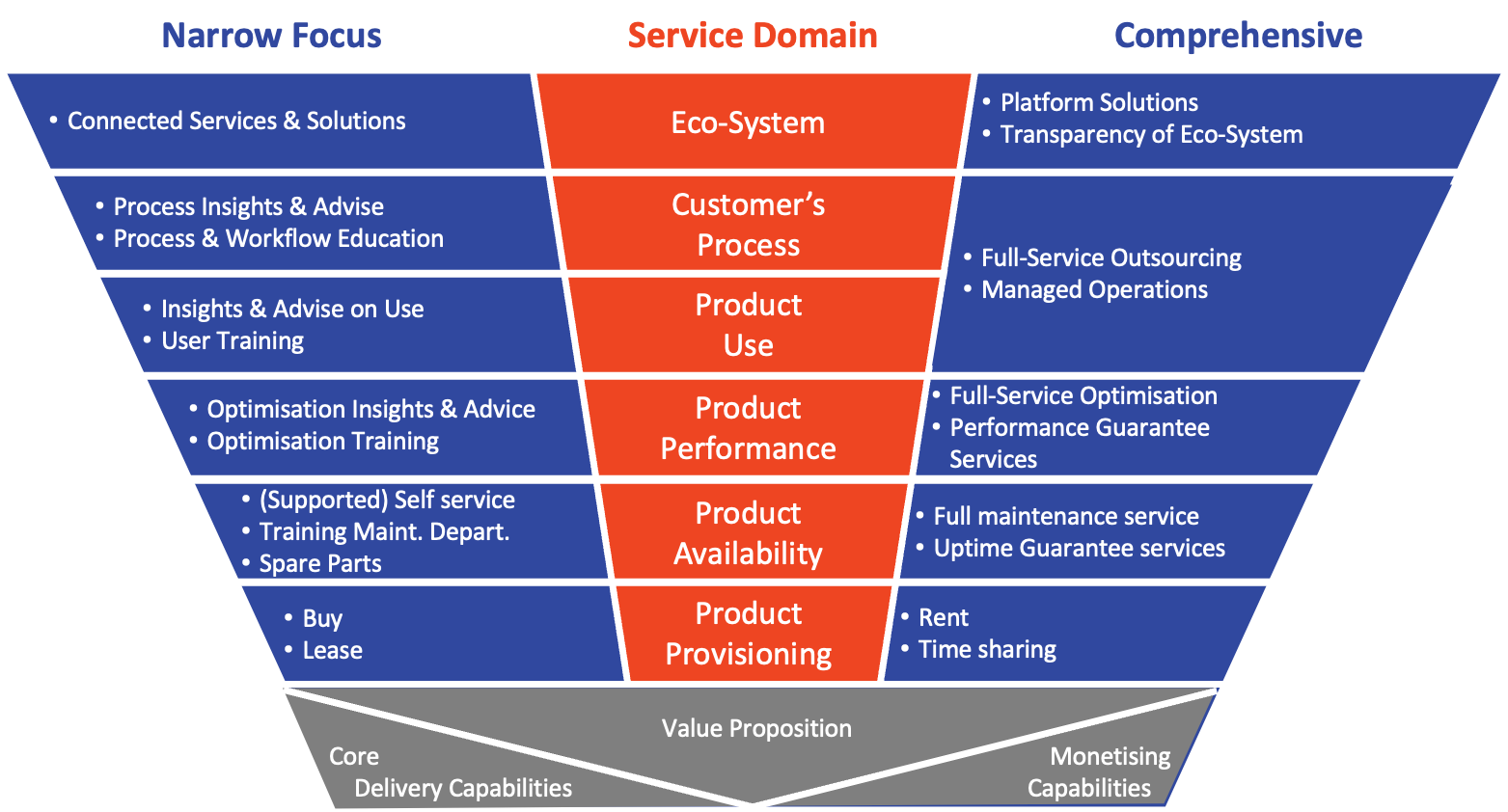Digital Services @ Epiroc
With today’s disruption from Covid and the economic downturn, continuing services innovation is paramount to survive and thrive. Customer needs are...
6 min read
Jan van Veen
Nov 22, 2023 12:39:50 PM

Agile Service Product Management is vital to thriving in the digital age. It encompasses the critical role of service product managers in driving customer satisfaction, revenue, and growth. By leveraging agile methodologies, they ensure service innovation and profitability, positioning businesses for competitive success and long-term sustainability in the service sector.
In today's rapidly evolving digital landscape, the agility of service product management has become more critical than ever.
This dynamic environment demands a responsive and flexible approach to managing service products that can swiftly adapt to changing market needs and technological advancements.
The service product management role is tasked with navigating through the complexities of digital transformation, ensuring that service products meet current market demands and are poised for future growth and innovation.
The service product manager coordinates this process, balancing strategic insight with operational efficiency, and aligning product development with market dynamics. Their leadership is essential in steering service products through the fast-paced changes of the digital era, making agile service product management a cornerstone for companies seeking to maintain a competitive edge and drive sustainable growth.
Ensuring customer satisfaction and effectively meeting demand is paramount in agile service product management. This requires a continuous process of assessing and understanding evolving customer needs and expectations. One of the essential techniques employed is active customer engagement through regular feedback mechanisms. These can include surveys, focus groups, and direct customer interactions, allowing real-time insights into customer experiences and expectations.
Moreover, the utilisation of data analytics plays a crucial role. Service product managers can identify trends and emerging needs by analysing customer usage patterns, preferences, and feedback. This data-driven approach enables the customisation of services, ensuring they resonate with different customer segments.
Customisation involves tailoring services to address specific challenges or requirements of diverse customer groups. This might mean offering varying service complexity levels, service delivery flexibility, or creating segment-specific features. Such strategies enhance customer satisfaction and foster a sense of value and relevance among customers.
Agile service product management, therefore, centres on an ongoing cycle of understanding and responding to customer needs. By employing these techniques and strategies, service product managers can ensure their offerings stay relevant, valuable, and appealing across various customer segments, thereby driving customer satisfaction and loyalty.
In agile service product management, driving revenue and profitability is a multi-faceted endeavour, hinging on the strategic alignment of service offerings with revenue generation goals. An essential approach is the development of monetisation models that align with customer value. This could involve tiered pricing strategies, where different service levels are offered at varying price points, or value-based pricing, which sets prices based on the perceived value to the customer.
Monitoring and optimising profitability requires focusing on the equation's revenue and cost sides. Utilising key performance indicators (KPIs) such as profit margins, customer lifetime value, and acquisition costs helps make informed decisions. Regularly reviewing these metrics ensures that the service offerings remain financially viable and meet profitability targets.
Balancing cost-effective service delivery with providing high-value solutions to customers is another critical aspect. This involves streamlining operational processes to reduce costs, leveraging technology for efficiency, and maintaining high service quality. Cost reduction should not come at the expense of service quality, as this could negatively impact customer satisfaction and revenue.
By employing these approaches, service product managers can effectively link their strategies to revenue generation and profitability. The goal is to create a sustainable model where cost efficiencies are maximised without compromising on the value delivered to customers, thereby ensuring the long-term financial success of the service offerings.
In the ecosystem of agile service product management, integrating cross-functional collaboration is vital for achieving cohesive and effective service offerings. It involves creating synergies between departments such as service development, marketing, sales, and other related functions. Such an integrated approach ensures that all teams are aligned with the service's vision, objectives, and customer needs.
Sharing insights and data across these teams is another cornerstone of this collaboration. All teams can access critical information by leveraging a unified data platform, including customer feedback, market trends, performance metrics, and operational data. This transparency allows for informed decision-making and strategy formulation. For instance, marketing can use insights from the service development team to craft more targeted campaigns, while sales can provide frontline feedback to service development for continuous product improvement.
This cross-functional collaboration is not just about information sharing; it's about fostering a culture of mutual understanding and joint responsibility. When teams across different functions understand and appreciate each other's roles and challenges, it leads to more effective problem-solving, innovation, and a unified approach to delivering exceptional service products. This enhances the overall agility and responsiveness of the service product management process, driving better outcomes for the business and its customers.
In agile service product management, crafting a vision and strategy aligning with business objectives and customer demands is critical. This process involves clearly understanding the company's long-term goals and how the service can contribute to these objectives. Simultaneously, it requires an acute awareness of customer needs and market dynamics. The strategy should include current market conditions and anticipate future trends and shifts, ensuring the service remains relevant and competitive.
Anticipating future market needs is a crucial facet of this strategy. It involves forward-thinking and scenario planning to envisage how customer preferences, technological advancements, and market landscapes might evolve. This foresight enables service product managers to position their services proactively, adapting and innovating ahead of market changes. The goal of these strategic aspects is to create a service that meets immediate market demands and is poised to adapt and thrive in the future marketplace.
Central to agile service product management are the operational aspects, which focus on ensuring the effective delivery and management of the service product throughout its lifecycle. This requires a comprehensive approach to overseeing every stage of the service — from initial development and launch to growth, maturity, and eventual evolution or retirement. Operational effectiveness hinges on robust process management, ensuring that each service lifecycle stage is executed efficiently and aligned with the strategic objectives.
Incorporating feedback loops is a crucial element in this operational framework. These loops involve continuously gathering and analysing feedback from various stakeholders, including customers, frontline employees, and cross-functional teams. This feedback becomes a valuable source of insights for continuous improvement and adaptation of the service. It allows service product managers to make data-driven decisions, refine service offerings, and rapidly respond to emerging challenges or opportunities. By prioritising these operational aspects, service products can maintain high standards of quality and relevance, adapting swiftly to changing market and customer needs.
In agile service product management, addressing market aspects is essential for the success of any service product. This involves developing and implementing effective strategies for marketing and selling the service. It begins with a deep understanding of the target market, including customer demographics, preferences, and pain points. This knowledge is then used to craft compelling value propositions and marketing messages that resonate with the intended audience.
A significant part of market strategy is identifying and capitalising on emerging market opportunities. This requires staying attuned to industry trends, competitive landscapes, and technological advancements. By being proactive and responsive to these market dynamics, service product managers can position their services advantageously, exploiting niches or untapped areas that offer potential for revenue and growth.
Effectively tackling these market aspects means attracting new customers and retaining existing ones, thus driving sustainable growth. It's about creating a market presence that draws attention and builds lasting relationships with customers, thereby establishing a robust and revenue-generating foothold in the market.
Incorporating Agile methodologies into service product management transforms how services are developed and managed, bringing flexibility and responsiveness to the forefront. Tailoring Agile principles specifically for service product management involves adopting iterative development, continuous feedback, and cross-functional collaboration. This approach ensures service development is customer-focused, adaptable, and aligned with changing market demands.
Utilising sprints, a fundamental component of Agile, allows for rapid development and quick adaptability. These time-boxed periods focus on achieving specific goals, enabling teams to develop, test, and refine services in manageable increments. This process fosters a dynamic environment where adjustments can be made swiftly in response to new insights or changing requirements.
Effectively managing the service product backlog is another crucial aspect. This prioritised list of tasks and features is continuously reviewed and updated, ensuring the team's efforts focus on items that offer the highest market relevance and business value. By regularly re-evaluating the backlog, service product managers can adapt their strategies to current market needs, ensuring that the service remains competitive and valuable to customers.
Successfully transforming service offerings in the digital age is a high-stakes endeavour with significant implications.
On the one hand, mastering this transformation can lead to remarkable growth in the service business, setting a foundation for market leadership and sustained competitive advantage. It opens avenues for new revenue streams, enhances customer loyalty, and solidifies a company's reputation as an innovator.
On the other hand, failure to adapt can result in stagnation, market share loss, and customer trust erosion.
The stakes are clear: evolve and thrive, or risk falling behind in an increasingly digital-driven market.
The role of a service product manager in today's digital era is multifaceted and crucial, with a comprehensive impact that extends across various aspects of a business. These professionals stand at the forefront of meeting customer demands, driving revenue, and ensuring profitable growth.
They deftly balance strategic vision with operational efficiency while maintaining a keen eye on market dynamics. Agile methodologies are pivotal in this process, providing the flexibility and responsiveness needed to innovate and adapt in a fast-paced digital landscape. This agility enhances service innovation, boosts customer satisfaction, and significantly contributes to business profitability.
Ultimately, the success of service transformation in this digital age heavily relies on the effectiveness of service product management. Embracing this role and its responsibilities is beneficial and vital for any business aspiring to succeed and grow in the service sector.

The Service Transformation Summit on Advancing Your Service Innovation Capabilities covered the content of this article and more, such as:
This Summit, which took place on June 5-6, 2024, was a unique opportunity to deepen your understanding of these topics, connect with industry leaders, and engage in enriching discussions about real-world cases of your like-minded peers.
So, if you're passionate about service transformation and are committed to sparking positive change in your organization, we warmly invite you and your service leadership teams to join us at our upcoming Summits.
Let's transform the service industry together.
Subscribe for the our Impulse Letter
With regular updates about service news, trends and best practices.

With today’s disruption from Covid and the economic downturn, continuing services innovation is paramount to survive and thrive. Customer needs are...

To drive sustainable growth and differentiation, B2B manufacturers must expand their service innovation beyond predictive and remote services by...

Shifts in your industry will happen anyway. You need to embrace cannibalism of your products and services to thrive. The real question is; are you a...